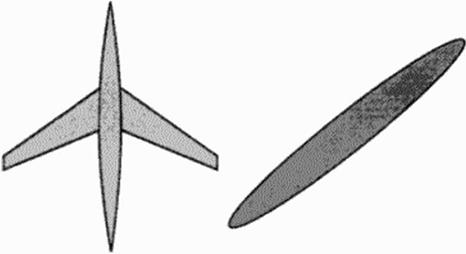Transonic Cruise
Because an SCT generates an annoying sonic boom as long as it flies faster than the speed of sound, supersonic operation will be limited to uninhabited areas, i. c. mainly over sea. Over populated areas SCTs have to cruise at subsonic speeds. But many important airports like Chicago. Atlanta, Denver. Frankfurt etc. arc far away from sea and many routes contain an important part of flight over populated land Therefore routings over uninhabited areas arc preferred, even at slightly increasing distances, but large subsonic cruise legs remain, Figure 16 It is estimated, that
an SCT must be able to cruise subsonically during one fourth to one third of the whole distance.
|
Figure 16 Supersonic Detour Routing |
Therefore a new SCT must provide good transonic (i. e. high subsonic) cruise performance. in contrast to Concorde’s poor subsonic performance, In addition to engines which provide good subsonic efficiency, aerodynamic design must provide this performance.
At high subsonic (transonic) cruise, good performance is achieved without significant contribution of wave drag. i. e. just below drag rise. So. in the drag composition of eqs. (49) and (50) the two wave drag terms can be omitted:
Cp = A/S •Cf + Kr SC2L/(Kb2) (55)
or in physical units
D = ACfq + К і • W2(Jt<//>2) (56)
Here mainly the sum of friction and induced drag has to be minimized and to be balanced with the other design requirements
The terms for fnction and induced drag arc described in chapter 2 after eqs. (49) and (50). Because here the flight is subsonic, supersonic leading edges do not exist. But optimum angle of attack is higher than at supersonic cruise. Therefore flow at relatively sharp or even really wedge-sharp leading edges may separate, producing high vortex drag which has to be avoided by suited leading edge flap deflections
To minimize high subsonic drag, we have to
minimize drag components by to optimizing geometry components:
friction drag surface. Cf (laminanzation)
induced drag span resp aspect ratio, and avoid separation
Therefore subsonic airliners have highly loaded high aspect ratio wings, sec Figure 17. This requirement contrasts to the supersonic cruise requirements. Here length I or l0 ts only required to delay the drag nsc Mach number, and for flight stability and control. The best solution would be a variable geometry, which was proposed by Boeing for the first US-SST. But the high weight of large movable pans prevented such a solution. In contrast, the Oblique Flying Wing (OFW) (56] provides variable geometry without large moving pans; therefore it is the bet[7] ter solution.
|
|
Figure 17 Transonic Cruise Aircraft













